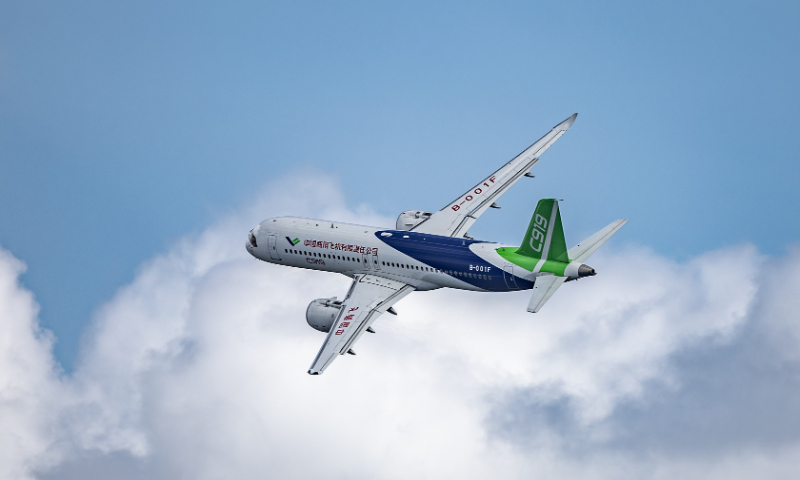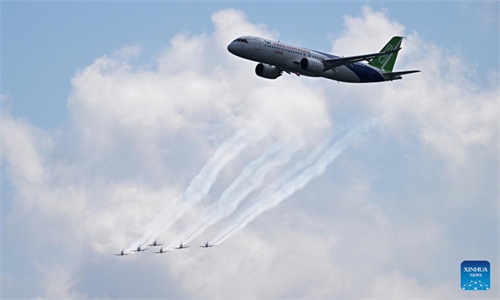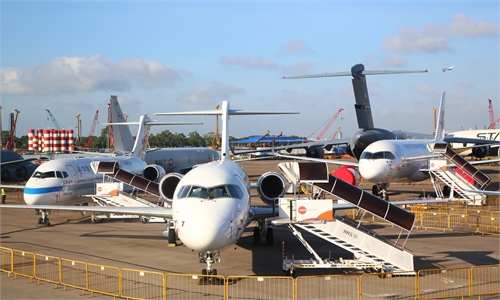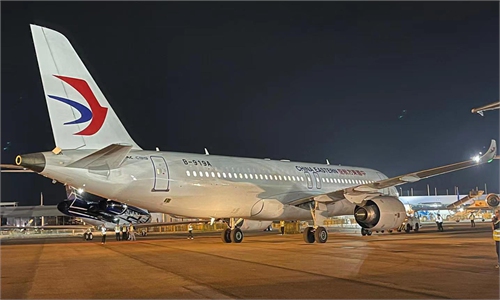Singapore Airshow, starting point for C919 to step onto world stage: Global Times editorial

The C919 aircraft is seen at a flight performance during the 2024 Singapore Airshow on February 20, 2024. Photo: VCG
The Singapore Airshow opened on February 20 at the Changi Exhibition Centre, featuring the debut of two C919 and three ARJ21 aircraft from Commercial Aircraft Corporation of China (COMAC). This marks the first time that domestically produced large Chinese aircraft have been showcased at an overseas airshow, generating significant attention. Foreign professional organizations, in particular, have referred to the C919 as "the most scrutinized aircraft" and "one of the most anticipated features" at the airshow, considering it a milestone in some sense. The US media CNN sees this as a prominent symbol of Beijing's broader "Made in China" strategy, while Indian media believes that over the last couple of years, the international aviation industry has been going through a downturn despite the growth in air travel and the showcasing of the C919 comes at the right time. This points not only to aviation's recovery sector but also to China's impact on the global aviation market.
Today, China is widely recognized as a global manufacturing powerhouse. As the shining jewel in the crown of manufacturing, how do China's domestically made large aircraft perform? In the past, most people only saw them in the news. The debut of the C919 at the Singapore Airshow not only includes indoor model exhibitions but also outdoor static displays and flight performances, providing the international market with a close-up opportunity to get acquainted with China's domestically produced large aircraft. The actual results align with the analysis of foreign professional organizations: Among over 1,000 companies from more than 50 countries and regions and around 50,000 visitors attending the airshow, "there is a lot of interest to see the actual aircraft, how it performs and how it is in flight."
Prior to this, the C919 had already achieved satisfactory results in its operations within China. Since successfully completing its first commercial flight in May of last year, it has delivered four aircraft, safely transporting over 110,000 passenger trips. Currently, the C919 has orders for more than 1,000 aircraft, including intentions from overseas buyers. The active participation of the C919 in the Singapore Airshow is a proactive response to the scrutiny of the global audience, showcasing not only confidence in its own capabilities and technical performance but also a demonstration of its eagerness to actively participate in international market competition.
However, we also notice that the debut of the C919 has raised some eyebrows among Western public opinion. CNN and some other foreign media outlets have mentioned that the C919's overseas debut comes at a time when Boeing is making headlines for all the wrong reasons. "China has made no secret of its ambition to eventually compete against Boeing and Airbus," according to the CNN report, as if we are taking advantage of others' difficulties.
We believe that this is a misunderstanding of China's development of domestically produced large aircraft and its commitment to the path of independent innovation. The Chinese people are confident, humble and pragmatic in the path to Chinese modernization. We focus on our own things, not laugh at others.
Specifically regarding domestically produced large aircraft, we are well aware that as a "game for the brave," large aircraft require significant investment and a long time, having high risks and strong uncertainties. The road to successfully developing and launching a product into the market, and then moving toward commercial success, is full of variables. The C919 took 16 years from project initiation to successful test flight, with a difficult process and countless efforts. Its achievements today undoubtedly demonstrate the strong overall level of China's industrial technology, and the Chinese people have every reason to be proud of its step-by-step progress.
At the same time, we have never been complacent or arrogant about this. We position the C919 as a participant in the international market, not a challenger. The C919 is just getting started, and there is still a long way to go. Looking at aviation history, it is not uncommon to see aircraft models that have completed the product development stage but failed in the market promotion process. Now the commercial delivery and operation of China's domestically produced large aircraft has also begun, whether we can succeed in this step, we are still working hard. Airbus took about 40 years to achieve balance with Boeing. For China's domestically produced large aircraft, the current focus is on expanding international market awareness and winning recognition.
The Civil Aviation Administration of China recently announced that it will promote C919 commercial aircraft to acquire certification from the European Union Aviation Safety Agency. Once successful, the C919 will be able to perform commercial flights in most regions around the world. Many Western media believe that obtaining the US and European certification will not be easy considering the tense geopolitical relations. We hope that the US and European civil aviation authorities will evaluate the C919 based on international standards. Let media analysis remain just analysis, without letting politicization become a reality. At the same time, for the C919, true competitiveness comes from its own technological and operational efficiency. US and European certification can only determine the speed at which the C919 enters the international market, but it cannot determine the final outcome.
After the C919 completed its first commercial flight last year, the CEO of Boeing once said that being "overly anxious" about the C919 is "a silly prospect," and that "three providers in a growing global market of this size and scale should not be the most intimidating thought in the world." This is a rational mentality, and Western politicians in particular should be accustomed to this mind-set of healthy competition. China is not a challenge or a threat, but a contributor to making the global cake bigger and a new engine for growth.



